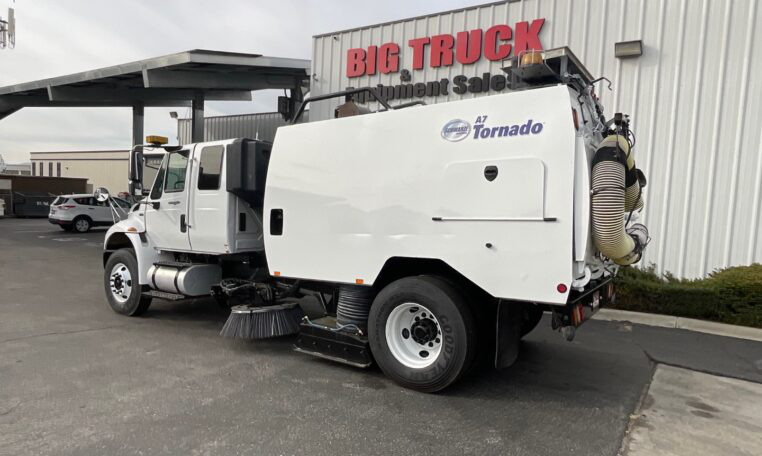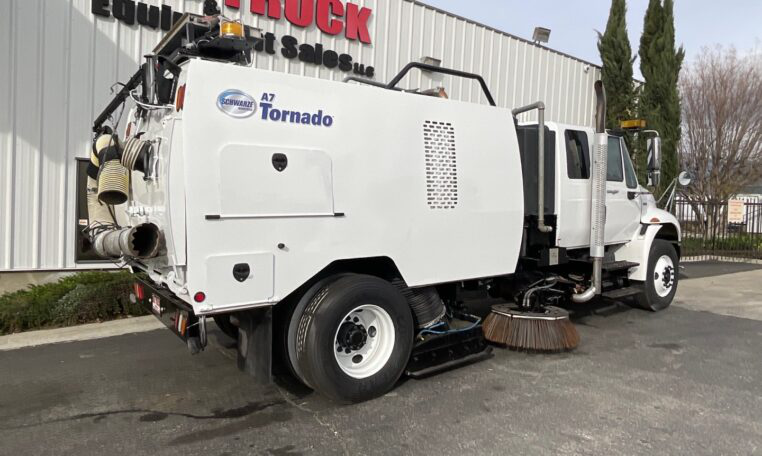Efficiency Overdrive: Strategies to Improve Fuel Efficiency in Commercial Vehicles
- June 17, 2024
- Uncategorized
- Posted by admin
- Leave your thoughts

Fuel efficiency is an important factor in the profitability and sustainability of commercial truck fleets. With the rising cost of fuel and increasing environmental regulations, fleet managers are under pressure to reduce fuel consumption and operating costs.
Here are some practical tips and technologies to help improve fuel efficiency in commercial vehicles.
Regular Maintenance

For bucket truck drivers, keeping fuel costs in check is an ongoing concern. While factors like driving habits and job site conditions play a role, the unsung hero of fuel efficiency is often overlooked: routine maintenance. A well-maintained bucket truck simply runs better, translating to fewer wasted gallons at the pump.
Tire Pressure: A Silent Culprit
Underinflated tires create increased rolling resistance, forcing the engine to work harder to maintain speed. This translates directly to higher fuel consumption. By following the manufacturer’s recommended tire pressure for both loaded and unloaded conditions, drivers can ensure their tires are rolling smoothly and efficiently.
Regular tire inspections should also be part of the routine, checking for any signs of wear or damage that could further impact fuel economy.
Engine Performance: Keeping it Tuned
Just like any other vehicle, a bucket truck’s engine benefits greatly from regular tune-ups and oil changes. A well-tuned engine runs smoother, minimizes internal friction, and ultimately uses less fuel to deliver the same power. Dirty or old oil can also hinder engine performance, leading to increased fuel consumption. By adhering to the manufacturer’s recommended service intervals for tune-ups and oil changes, drivers can ensure their engine is operating at peak efficiency for optimal fuel economy.
Alignment Matters Too
Proper wheel alignment is another often-underrated aspect of fuel efficiency. Misaligned wheels create unnecessary drag, forcing the engine to work harder. Regularly checking and correcting wheel alignment ensures your bucket truck is rolling straight and true, maximizing fuel efficiency over the long haul.
Aerodynamic Enhancements

For bucket truck drivers, maximizing fuel efficiency translates directly to increased profitability. Every gallon saved adds to the bottom line. One often-overlooked factor significantly impacting fuel consumption is aerodynamic drag.
Imagine pushing your hand through the air – flat and open creates more resistance than a streamlined edge. The same principle applies to your bucket truck. As it travels down the road, air resistance, or drag, acts like an invisible brake, forcing the engine to work harder and burn more fuel.
The good news? This drag can be significantly reduced through the use of aerodynamic devices. These add-ons help your bucket truck slice through the air more efficiently, leading to improved fuel economy.
Modern Solutions for Classic Challenges

Traditional aerodynamic devices, like side skirts and tail fairings, have been around for years. However, advancements in design and materials have made them more effective and user-friendly than ever before. Here’s a closer look:
Side Skirts: These panels run along the sides of the truck chassis, effectively closing the gap between the truck body and the road. This smooths airflow, reducing turbulence and drag.
Tail Fairings: Attached to the rear of the truck, these devices help manage airflow exiting the vehicle. By redirecting air and minimizing turbulence, they significantly reduce drag.
Roof Deflectors: Mounted on the top of the cab, these deflectors help channel air over the roof and trailer, improving airflow and reducing drag.
Modern materials used for these devices are not only lightweight but also more durable, making them easier to install and maintain while withstanding the rigors of daily use.
Driver Training Programs
The way a bucket truck is driven has a major impact on fuel efficiency. Implementing driver training programs can educate operators on best practices that not only save fuel but also extend the life of the vehicle. Here’s how driver habits can influence fuel consumption:
Smooth Operation: Maintaining a steady speed and avoiding harsh acceleration and braking can significantly improve fuel efficiency. Encouraging drivers to anticipate traffic signals and road conditions allows for smoother driving and reduces the need for sudden stops and starts.
Cruise Control (when applicable): On highways and open roads, utilizing cruise control can help maintain a constant speed, reducing the fuel wasted during constant acceleration adjustments.
Idle Reduction: Excessive idling is a major culprit in wasted fuel. Training drivers to minimize idling time, such as shutting down the engine during short breaks, can significantly reduce fuel consumption. Consider installing automatic idle shutdown systems to further enforce this practice.
Route Planning: Efficient route planning can minimize travel time and distance, directly impacting fuel use. Training drivers to utilize GPS navigation and plan routes that avoid congestion can lead to significant fuel savings.
Use of Advanced Technologies
By incorporating advanced technologies, bucket truck drivers can significantly improve their vehicle’s fuel efficiency.
Data-Driven Decisions: GPS and Telematics
Imagine having a real-time coach whispering fuel-saving tips in your ear. That’s essentially what GPS and telematics systems offer. These sophisticated systems provide a wealth of data on your vehicle’s performance and route optimization. They can track:
Traffic patterns: By analyzing traffic data, drivers can avoid congested areas and reroute when necessary, reducing unnecessary idling and stop-and-go driving – a major culprit for fuel waste.
Fuel consumption: Telematics systems can monitor fuel usage in real time, pinpointing areas for improvement and allowing drivers to adjust their driving habits accordingly.
Route optimization: Advanced systems can suggest the most fuel-efficient routes based on factors like distance, traffic conditions, and terrain.
Improving fuel efficiency in commercial vehicles is a multifaceted approach that involves regular maintenance, driver training, and the adoption of new technologies. By implementing these strategies, fleet managers can achieve significant cost savings and contribute to a more sustainable environment.
For those looking to invest in high-quality used bucket trucks, head on over to Big Truck & Equipment Sales today!
We are the leading choice for robust vacuum trucks, used bucket trucks for sale, digger derrick trucks, and much more. Contact us today to learn more about our Vacuum trucks for sale in NM.
